 |
51 (10) (1999), pp. 14–16. |
|---|
 |
51 (10) (1999), pp. 14–16. |
|---|
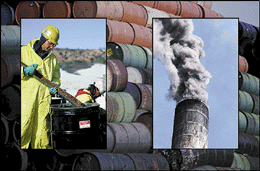 |
| TABLE OF CONTENTS |
|---|
Waste streams that have shown substantial benefit from the PACT process are low-level nuclear waste (LLW), paints, pharmaceutical sludges, pyrotechnics, military chemical agents, blast media, and solvents. Common features among these wastes are the presence of heavy metals and often heterogeneous mixtures of organic materials, soils, metals, and water.
The PACT system meets all of the U.S. Environmental Protection Agency's (EPA)'s requirements for air emissions through high-temperature treatment and system design. Pilot-scale tests were performed for the EPA SITE Superfund Program on wastes from Silverbow Creek and the Montana Pole plant in Butte, Montana, in July 1991. The achieved DREs for hexachlorobenzene, an added organic spike, were 99.9984%, 99.9991%, and 99.9999% for tests one, two, and three, respectively.3 The EPA limit is 99.99%.4 The numbers represent detection limits (no measurable amounts were detected).
In 1996, 31 tests on nine different waste streams were conducted for the U.S. Army Environmental Command, Aberdeen Proving Grounds, Maryland. The principal heavy-metal spikes were barium, chromium, and lead.5 Table I shows the leach rates from some of the tests and how they compare to the EPA regulatory limits. Leachate concentrations of hazardous organics were also examined; all were below detection limits.
| Table I. A Comparison of Leach Rates to EPA Regulatory Limits* | |||
|---|---|---|---|
| Waste | Barium (mg/l) | Chromium (mg/l) | Lead (mg/l) |
| Medical Ash (Test 1R) | 0.169 | 0.151 | 0.313 |
| Open Burning Soil (Test 8R) | 0.274 | 0.151 | 0.795 |
| Walnut Shell Blast Media (Test 14) | 0.0825 | 0.0714 | 2.79 |
| Longhorn Sludge (Test 12) | 2.460 | 0.0799 | 1.180 |
| Regulatory Limits | 100.0 | 5.0 | 5.0 |
| * From U.S. Army tests, contract no. DAA21-93-C-0046. | |||
The estimated 6,000°C temperatures generated by plasma and the centrifugal action allow one PACT system to treat a variety of heterogeneous wastes with different melting points. It also means that PACT systems can treat their own fly ash plus filtration media, minimizing secondary wastes. Volume reductions for LLW stored waste (including containers) can range from 7:1 for drums containing mostly metals to 270:1 for primarily organic wastes. The centrifugal action of PACT also produces homogeneity, which adds to strength and long-term durability.
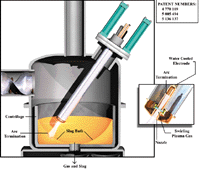 |
| Figure 1. The PACT system. |
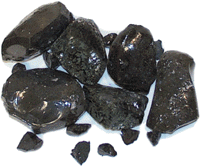 |
| Figure 2. Slag generated in the PACT process meets all applicable EPA disposal requirements, and ranks well in long-term durability (PCT) tests. |
A transferred plasma arc is chosen for the system, principally because energy is transferred into the waste material to be heated more efficiently than with a nontransferred arc. A further advantage of plasma is that temperature can be increased at full system capacity without affecting the system off-gas volume.
Feeders for unopened 200 liter drums minimize pretreatment handling and are designed for either vertical or horizontal loading directly into the system. Horizontal drums are remotely cut open as they rotate inside the confines of the system. Vertically loaded drums are usually the heaviest (500 kg or more) and are batch melted. With limited characterization of drum contents, the operator can determine the initial power and feed rates.
| Table II. PACT-8 Feed Rates in July 1999 at Retech | |||
|---|---|---|---|
| Waste | Feed Rate (kg/h) | kW | Feeder |
| Latex Paint | 450 | 750 | Liquid |
| Cement Block, Metal, Insulation | 975 | 1,200 | Archimedes |
The centrifugal mixing that produces uniform chemistry is also important to slag durability. Leach-test data show that high-melting slags made by plasma are very leach-resistant.
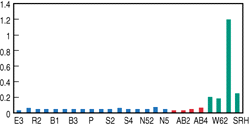 |
| a |
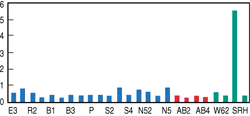 |
| b |
| Figure 3. Results of seven-day product-consistency tests for (a) silicon and (b) sodium, designed to evaluate the long-term durability of the slag matrix. |
Slag is poured, by reducing the centrifuge rpms, through an axial throat into a mold within a collection chamber. Slag-mold volumes for the same-size PACT system can vary from one project to another, depending on customer requirements. For example, PACT-8 slag molds (the number refers to nominal centrifuge inside diameter in feet) have been as small as 0.15 m3 and as large as 0.6 m3. A safety mold is in position below the centrifuge at all times, except when pouring. Any material that might pass through the central pour orifice untreated is collected and fed back into the PACT system. The safety mold also acts as a container for the centrifuge contents in case of power failure.
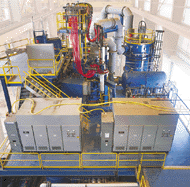 |
| Figure 4. The top deck of the PACT-8 system assembled at Retech for acceptance testing prior to the proposed installation at the Norfolk Naval Base. |
References
1. R.C. Eschenbach and K.D. Boomer, "Plasma Arc Stabilization of Hazardous Mixed Wastes" (Paper presented at the ANS Winter Meeting, Los Angeles, CA, 15–19 November 1987).
2. M.P. Schlienger, U.S. patent 4,770,109 (September 13, 1988); U.S. patent 5,005,494 (April 9, 1991); U.S. patent 5,136,137 (August 4, 1992).
3.Retech Plasma Centrifugal Furnace Application Analysis Report (Cincinnati, OH: EPA, Risk Reduction Engineering Laboratory, June, 1992), p. 9.
4. "U.S. Code of Federal Regulations," 40 CFR (07/01/90 Edition) Paragraph 264.343(c).
5. Plasma Arc Technology Evaluation, Scientific and Technical Report (City: NDCEE, 1997), Table 6A.
6. R.C. Eschenbach, "Plasma Arc Centrifugal Treatment (PACT) of Hazardous Waste" (Paper presented at the 8th Symposium on Plasma Science for Materials, Tokyo, Japan, 15–16 June 1995).
7. R.C. Eschenbach, X. Feng, and R.E. Einziger, "A Direct, Single Step Plasma Arc-Vitreous Ceramic Process for Stabilizing Spent Nuclear Fuels, Sludges, and Associated Wastes" (Paper presented at the Scientific Basis for Nuclear Waste Management XX, Boston, MA, 2–6 December 1996).
8. Y. Tsuji et al., "PACT Solidification Tests on Surrogates for Low Level Waste from Nuclear Power Plants," Proceedings of the 1994 Incineration Conference (City: Publisher, 1994), pp. 151–153.
9. Y. Nakayama et al., "Cobalt and Cesium Volatility Test in Plasma Arc Centrifugal Treatment," Proceedings of the 1995 Incineration Conference (City: Publisher, 1995), pp. 427–429.
10. R.C. Eschenbach and C.G. Whitworth, "Glassy Slag from Rotary Hearth Vitrification" (Paper presented at the American Ceramic Society Meeting, Cincinnati, Ohio, 30 April–4 May 1995).
R.K. Womack is business development manager for Retech Services, Inc., a Lockheed Martin Company.
For more information, contact R.K. Womack, Retech Services, Inc., P.O. Box 997, Ukiah, California 97482; (707) 467-1721; fax (707) 467-1638; e-mail ronald.k.womack@lmco.com.
Direct questions about this or any other JOM page to jom@tms.org.
| Search | TMS Document Center | Subscriptions | Other Hypertext Articles | JOM | TMS OnLine |
|---|